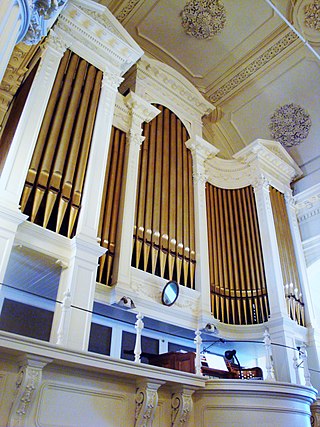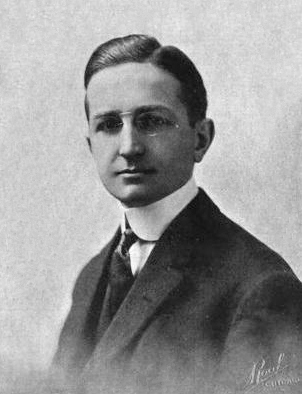This article needs to be updated.(April 2009) |

Tellers Organ Company was a manufacturer of pipe organs in Erie, Pennsylvania. From 1906 to 1973, the company produced over 1,100 organs throughout the United States and Puerto Rico.
This article needs to be updated.(April 2009) |

Tellers Organ Company was a manufacturer of pipe organs in Erie, Pennsylvania. From 1906 to 1973, the company produced over 1,100 organs throughout the United States and Puerto Rico.
The company was founded by two brothers, Henry and Ignatius Tellers, and William Sommerhof. Prior to this, the two Tellers brothers worked at Milwaukee, Wisconsin based Schuelke Organ Company until 1892. They moved to Erie and went to work for the Felgemaker Organ Company for the next 14 years, where they met Sommerhof.
In 1906, the three men established Tellers Organ Company. In 1911, the company changed its name to Tellers-Sommerhof Organ Company. Sommerhof would sell his interest in the company to A. E. Kent, another former Felgemaker employee, in 1918. The company's name was then changed to Tellers-Kent Organ Company. Felgemaker also ceased operations that year. Tellers-Kent assumed all the open contracts and service agreement work from Felgemaker. The company was known as Tellers-Kent for a number of years until the name changed back to Tellers Organ Company.
The company would eventually become a pioneer in the combination pipe/electronic organ fields and would come to produce the Conn-Tellers Electro-Pipe Combination Organ. The company later became an authorized Rodgers Instruments dealer.
Lawrence Phelps purchased the Tellers factory in 1973 and established the Lawrence Phelps & Associates organ building firm. [1] Phelps would produce organs in Erie until the company went out of business in 1981. [2]

Æolian-Skinner Organ Company, Inc. of Boston, Massachusetts was an American builder of a large number of pipe organs from its inception as the Skinner Organ Company in 1901 until its closure in 1972. Key figures were Ernest M. Skinner (1866–1960), Arthur Hudson Marks (1875–1939), Joseph Silver Whiteford (1921-1978), and G. Donald Harrison (1889–1956). The company was formed from the merger of the Skinner Organ Company and the pipe organ division of the Æolian Company in 1932.

A theatre organ is a type of pipe organ developed to accompany silent films, from the 1900s to the 1920s.

Casavant Frères is a Canadian organ building company in Saint-Hyacinthe, Quebec, which has been building pipe organs since 1879. As of 2014, the company has produced more than 3,900 organs.

Ernest Martin Skinner was an American pipe organ builder. His electro-pneumatic switching systems advanced the technology of organ building in the first part of the 20th century.
The Holtkamp Organ Company of Cleveland, Ohio is America's oldest continuously operating pipe organ workshop. The company was founded in 1855 by Gottlieb Votteler. The work produced by the shop has evolved over the years in terms of architectural style, sound, and mechanism. During this time the company has had a number of names, including: The Votteler Organ Company, The Votteler-Hettche Organ Company, The Votteler-Holtkamp-Sparling Organ Company, and finally in 1951, The Holtkamp Organ Company.
Mathias Peter Møller, commonly known as M.P. Möller or Moeller, was a prolific pipe-organ builder and businessman. A native of the Danish island of Bornholm, he emigrated to the United States in 1872 and founded the M.P. Moller Pipe Organ Company in Greencastle, Pennsylvania, in 1875. The city of Hagerstown, Maryland, took notice of Möller's early successes and induced him to move his business there in 1881 to help make it a viable business center in Western Maryland. The company remained in business in Hagerstown until 1992, with hundreds of employees at its peak and a lifetime production of over 12,000 instruments.

Austin Organs, Inc., is a manufacturer of pipe organs based in Hartford, Connecticut. The company is one of the oldest continuously-operating organ manufacturers in the United States. The first instruments were built in 1893 with the Austin Patent Airchest, and many remain in fine playing condition to this day.
The Felgemaker Organ Company was a manufacturer of pipe organs based out of Erie, Pennsylvania, in the late 19th and early 20th centuries.
Organ Supply Industries, Incorporated is a pipe organ parts manufacturer founded in 1924 as the Organ Supply Corporation in Erie, Pennsylvania. With over 46,000 square feet (4,300 m2) of manufacturing floor, it is the largest organ parts supplier in North America.

J. W. Walker & Sons Ltd is a British firm of organ builders established in 1828 by Joseph William Walker in London. Walker organs were popular additions to churches during the Gothic Revival era of church building and restoration in Victorian Britain, and instruments built by Walker are found in many churches around the UK and in other countries. The firm continues to build organs today.
The William A. Johnson Organ Company of Westfield, Massachusetts, which later became Johnson & Son Organ Company, was a firm that built 860 pipe organs throughout the United States and in Canada and Bermuda. The company operated from 1844 through 1898. All Johnson organs were completely mechanical organs, with Barker lever tracker-pneumatic actions utilized in larger organs after 1871.
The Organ Reform Movement or Orgelbewegung was a mid-20th-century trend in pipe organ building, originating in Germany. The movement was most influential in the United States in the 1930s through 1970s, and began to wane in the 1980s. It arose with early interest in historical performance and was strongly influenced by Albert Schweitzer's championing of historical instruments by Gottfried Silbermann and others, as well as by Schweitzer's opinion that organs should be judged primarily by their ability to perform with clarity the polyphonic Baroque music of J. S. Bach (1685–1750). Concert organist E. Power Biggs was a leading popularizer of the movement in the United States, through his many recordings and radio broadcasts. The movement ultimately went beyond the "Neo-Baroque" copying of old instruments to endorse a new philosophy of organ building, "more Neo than Baroque". The movement arose in response to perceived excesses of symphonic organ building, but eventually symphonic organs regained popularity after the reform movement generated excesses of its own.

Charles Lloyd was a pipe organ builder based in Nottingham who flourished between 1859 and 1908.

Sacred Heart Cathedral, Sacred Heart School and Christian Brothers Home comprise a former Roman Catholic diocesan complex in the Central Hillside neighborhood of Duluth, Minnesota, United States. Sacred Heart Cathedral was built from 1894 to 1896 and served as the seat of the Roman Catholic Diocese of Duluth until 1957, after which it became a parish church. Sacred Heart School was built in 1904 and the Christian Brothers Home—a monastic residence for the school faculty—was built in 1907.

St Alban the Martyr, Birmingham is a Grade II* listed Church of England parish church in the Anglican Diocese of Birmingham. It is dedicated to Saint Alban, the first British Christian martyr.

The Cathedral Church of St. Luke is an Episcopal cathedral in Orlando, Florida, United States. It is the seat of the Diocese of Central Florida.

Our Lady of Lebanon Cathedral is a Maronite Catholic cathedral located in Brooklyn, New York, United States. It is the seat of the Eparchy of St. Maron of Brooklyn. It is located in the neighborhood of Brooklyn Heights in the oldest northwest section of the borough, across the East River from Manhattan. The church building originally housed the "Church of the Pilgrims" of the old Congregational Christian Church,.

Hinners Organ Company was an American manufacturer of reed and pipe organs located in Pekin, Illinois. Established in 1879 by German-American John Hinners, the firm grew through several partners, becoming Hinners & Fink in 1881, Hinners & Albertsen in 1886, and Hinners Organ Company in 1902. In the 1920s Hinners established a subsidiary, the Illinois Organ Supply Company, which mass-produced parts for Hinners and other firms. Business declined in the 1930s due to the Great Depression, changing technology, and increasing competition. Hinners became a service company in 1936 and closed in 1942.

St. Timothy's Church, Roxborough is a parish of the Episcopal Diocese of Pennsylvania in the Roxborough neighborhood of Philadelphia, Pennsylvania, United States. It is part of the Wissahickon Deanery of the Diocese of Pennsylvania. In 1962, St. Timothy's reported membership of 1,144 and weekly attendance of 849, while its 2022 reported attendance was 32 persons.
This article needs additional citations for verification .(April 2009) |